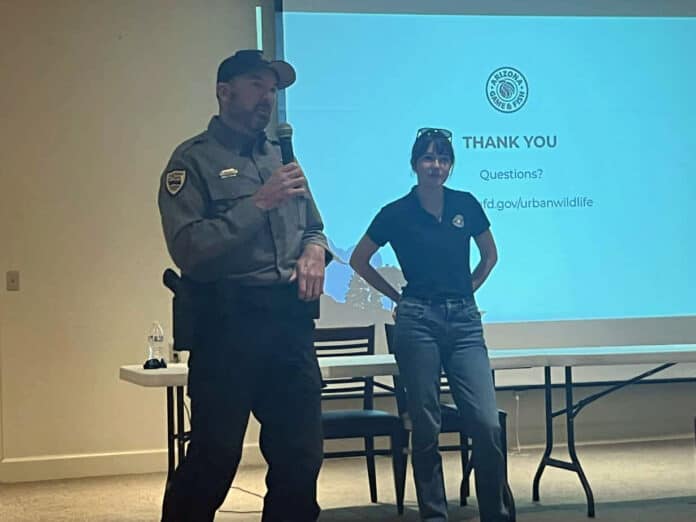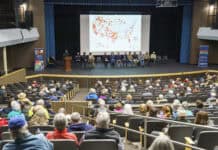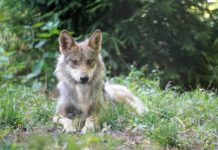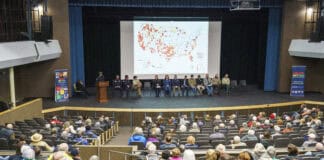
Arizona Game and Fish Department Supervisor Tim Holt and Public Affairs Community Liaison Stevie Kelso gave a presentation on nuisance wildlife to the Village of Oakcreek Association on Thursday, July 11, in response to reports of nuisance coyotes in the area that were made in early June.
“[A] category 1 animal is one that’s already bit somebody or hurt somebody,” Holt said. “A category 2 animal is one that has a potential threat to do so. A category 3 animal is considered one that’s been around for a while, just seems to be just causing problems … a general nuisance. And a category 4 animal is just a sighting … [All] these get logged into our database.”
“Once we showed up … we figured they were probably category 3,” Holt said of the local reports, adding that there have been no reported injuries to humans.
Unsubstantiated rumors recently circulated online about coyotes in the Village of Oak Creek being poisoned by an unidentified party. Holt said that he was made aware of the claims for the first time during the meeting and would follow up on the reports.
Representatives of the Runnin’ W. Wildlife Center, the U.S. Forest Service, the Yavapai County Sheriff’s Office and the Coconino County Sheriff’s Office all stated that there are no confirmed cases of coyote poisoning in either the Village of Oak Creek or Oak Creek Canyon.
The rumor appears to have been started when the Runnin’ W. Wildlife Center posted on social media on June 17 that it had treated an injured young coyote found near a local golf course.
“Originally admitted under the assumption of a car collision, it didn’t take long to realize something more dire was going on,” the post stated. “We immediately got him to Dr. Cinda Rajkovic at Complete Pet Care to take a look at it and see if we could determine what was going on … It was determined by the lab to be poison.”
Runnin’ W Wildlife Center Director Billy Harvey later confirmed that the coyote had been found on a Cottonwood-area golf course and was put down after it went blind. Harvey said that while the Runnin’ W has attended to two or three other animal poisonings within the last six months, none of those animals were found in the VOC.
“It was a rat poison that it had ingested, and at that age, more than likely the mother was eating it and regurgitating it back to the [young] coyote,” Harvey said.
Harvey said he believed that the coyote found in Cottonwood was “more than likely a secondary kill,” meaning that its death resulted from someone using rodenticide to kill rodents in the vicinity of the Cottonwood golf course, which were in turn eaten by the coyotes.
“This did not seem like criminal or intentional activity where we would immediately notify [Arizona Game & Fish Department] as such,” Harvey said. “They are aware of [the Cottonwood poisoning] and are in possession of the veterinarian report at the Kingman office currently.”
The Cottonwood poisoning coincided with the recent deaths of several VOC resident coyotes. Harvey said there was no physical evidence linking these events and toxicology screens were not done on any of the VOC animals.
“Six months ago, I had a family of six [coyotes] running around at night, and all of a sudden I started losing them,” VOC resident Thomas White said. White has been documenting coyotes on the Oakcreek Country Club golf course for the last eight years. “To lose five out of six [coyotes] in six weeks after watching a family grow for eight years, it just seemed out of place.”
Kelso said that the department received 59,351 calls during 2023, 7,518 of which involved “wildlife interactions that required some type of assistance from our department.”
Under Arizona law and hunting regulations, coyotes are classified as predators and may be legally killed by anyone in possession of a valid hunting license at any time of the year by any method other than falconry or slinging.
Per Arizona Revised Statute §13-2910(B), it is permissible to expose poison to predators on one’s own property for the purpose of protecting oneself or livestock.
Arizona Revised Statute §13-2910(B)
Arizona Revised Statute §13-2910(B) reads “It is a defense to subsection A [‘A person commits cruelty to animals if the person does any of the following’] of this section if:
“1. Any person exposes poison to be taken by a dog that has killed or wounded livestock or poison to be taken by predatory animals on premises owned, leased or controlled by the person for the purpose of protecting the person or the person’s livestock or poultry, the treated property is kept posted by the person who authorized or performed the treatment until the poison has been removed and the poison is removed by the person exposing the poison after the threat to the person or the person’s livestock or poultry has ceased to exist. The posting required shall provide adequate warning to persons who enter the property by the point or points of normal entry. The warning notice that is posted shall be readable at a distance of fifty feet, shall contain a poison statement and symbol and shall state the word “danger” or “warning”.
“2. Any person uses poisons in and immediately around buildings owned, leased or controlled by the person for the purpose of controlling wild and domestic rodents as otherwise allowed by the laws of the state, excluding any fur-bearing animals as defined in section [ARS §]17-101”
Arizona Revised Statute §17-101(B.10) reads: “‘Predatory animals’ means foxes, skunks, coyotes and bobcats.” Arizona Revised Statute §17-101(B.3) reads “‘Fur-bearing animals’ means muskrats, raccoons, otters, weasels, bobcats, beavers, badgers and ringtail cats”



















